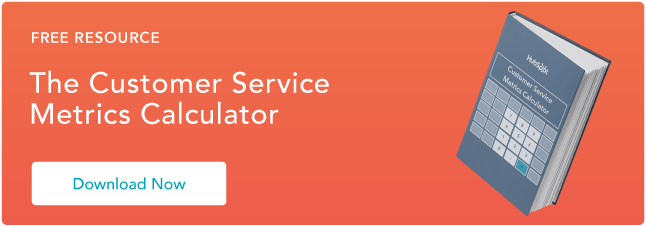Have you ever called a support line and were immediately put on hold before you could speak to a service rep? It's incredibly frustrating, and if that hold is long enough, it's common to just hang up the phone before ever speaking to a service agent.

Call centers categorize these instances as “abandoned calls.” While it’s nearly impossible to eliminate them altogether, service teams can strive to lower abandonment rates and improve customer satisfaction.
In this post, we'll explain everything you need to know about call abandonment rate including what it is, how to calculate it, and some industry benchmarks to compare your business to.
What's a Call Abandonment Rate?
Call abandonment rate is the percentage of people who hang up the phone before they're answered by a service rep. This tells you how often your support team can successfully provide a solution before the customer gets frustrated and abandons the call.
Ninety percent of consumers say an immediate response is "important" or "very important" when they have a customer service question. This means if your call abandonment rate is high, then your customers aren't gaining enough value from their service experience. The higher this percentage is, the more customers you'll have that have left the phone feeling unsatisfied and still in need of support.
If you're not sure what your call abandonment rate is, read on to the next section to learn how to calculate it.
How to Calculate Call Abandonment Rate
Calculating your call abandonment rate is relatively simple. You just need to follow the steps below.
1. Determine the number of calls you've received.
The first step is determining how many calls you've received during a given time. Typically, most companies will measure on a monthly basis, but you can use a week, year, or whichever period that fits your needs.
2. Subtract the number of calls you've handled.
Once you know how many calls you've received, the next step is to subtract the number of calls you've handled.
For this step, some businesses may define a "handled call" differently than others. For instance, calls that are shorter than five seconds may be categorized as abandoned because the interaction was very brief.
3. Divide the result by the number of calls you've received.
After you subtract the number of handled calls from the total calls received, the next step is to divide the difference by the number of calls received. This should give you a decimal value that you can multiply by 100 to get your percentage.
Here's what this formula looks like when it's written out.

Let's do a quick example.
Say our call center received 300 calls this month and our team handled 280 of them. That would mean our call abandonment rate is about 6.7% (300 - 280 = 20; 20/300 = 6.7%).
But, now that you know how to calculate your abandonment rate, how will you know if it's any good? To give you an idea of where you stand, read on to review some abandonment rate industry benchmarks in the section below.
Call Center Abandonment Rate Benchmarks
Like most customer service metrics, call center abandonment rates will vary by industry. That's because customer needs change depending on the product or service offered, resulting in different expectations for different companies.
That being said, on average most call centers should have a call abandonment rate between 5% and 8%. A 2021 global benchmarking Report from Talkdesk found an average abandonment rate of 5.91%. The pandemic also placed a heavier load on call centers which led to customers experiencing longer wait times.

With research conducted by Talkdesk, we can see what the standard is for abandonment rates across different industries like software, retail, and more.


Use these metrics as a ballpark guide when examining your own abandonment rate. Generating reports from call data will help you identify areas for improvement, in addition to informing you about what strategies are working well.
Now that you know how to calculate your call abandonment rate and are familiar with industry benchmarks, let’s explore ways to improve the call center experience for customers.
How to Lower Call Abandonment Rate
Managing a call center can seem like an uphill battle. It’s not enough to simply identify a high call abandonment rate. You’ll need to examine the data and find out what is causing the increase and why. However, there are a few things you can do to help make things run smoother for your team.
1. Automate repetitive tasks.
Set your service team up for success by saving them time by automating repetitive tasks. You can do this with tools like HubSpot’s Service Hub, which automates ticketing and other help desk functions.
2. Adopt a customer-in strategy vs. function-out.
One point of friction customers seem to face often when they call for support is the routing process. Customers speak with an agent, give them their contact information and explain their issue, then are transferred to another agent, only to have to repeat the same information they’d given the previous agent.

HubSpot CEO Yamini Rangan explains this is due to misaligned teams operating on a function-out model, which is designed around the function of the customer-facing team.
“Routing systems, asking customers for the same information over and over again — this is how companies bridge the gaps between different processes and behaviors. And unfortunately, customers are the ones who suffer because of it,” says Rangan.
A customer-in strategy requires understanding of the customer journey and focuses not on what is best for function, but what is best for the customer. In a call center environment, a customer-in strategy would focus on what customers need during each handoff or transition stage to give them a seamless experience.
Using a CRM tool that keeps customer information and correspondence in one place where agents have access will eliminate these pain points and cut down call time, freeing up agents to handle more calls.
3. Use a call back feature.
One way to prevent abandoned calls is to not have customers wait on hold for a representative to begin with. Allowing customers to opt for a call back instead of waiting on the phone for a representative frees up their time and provides a much better service experience. According to Talkdesk, 70% of customers cited a call back option as important.
4. Staff peak call times appropriately.
Use your call metrics to hone in on what times of day experience the highest volume of calls and schedule staff to accommodate this increase.
Importance of Call Abandonment Rate
Lowering your call abandonment rate ensures that you are able to handle more calls and provide customers with a better support experience. Long wait times have a negative impact on customer satisfaction and may eventually affect customer retention.
This article was originally published November 6, 2020 and has been updated for comprehensiveness.
![→ Download Now: Customer Service Metrics Calculator [Free Tool]](https://no-cache.hubspot.com/cta/default/53/e24dc302-9dc2-466f-a5ca-ab4e08633c0f.png)






![Artificial Intelligence Call Center: How is AI Used in Call Centers [+ How Will AI Impact Customer Service]](https://www.hubspot.com/hubfs/artificial-intelligence-call-center.webp)



